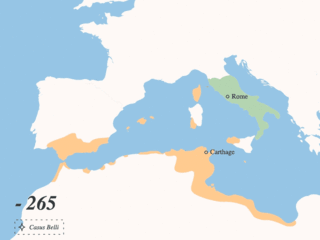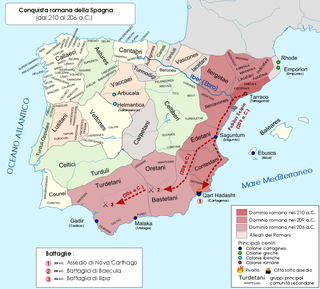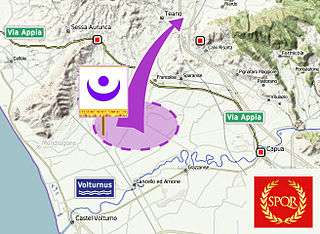Notes and references
- ↑ Bagnall, Nigel, The Punic Wars, p. 188, ISBN 0-312-34214-4
- ↑ Bagnall, Nigel, The Punic Wars, ISBN 0-312-34214-4
- ↑ Baker, G.P, Hannibal, p. 120, ISBN 0-8154-1005-0
Marcus Minucius Rufus (died August 2, 216 BC) was a Roman consul in 221 BC. He was also Magister Equitum during the dictatorship of Quintus Fabius Maximus Verrucosus known as Cunctator.
He was a political enemy of Fabius Maximus. He was against his delaying defensive strategy during the Second Punic War. While the Carthaginians had been busy at Geronium, Fabius had left Minucius in charge of the Roman army with instructions to follow the "Fabian strategy" and journeyed to Rome to observe some religious duties. [1] Minucius, who had always advocated a more forward strategy against Hannibal, moved down from the hills after a few days and set up a new camp in the plain of Larinum to the north of Geronium. The Romans then began harassing the Carthaginian foragers from their new camp as Minucius sought to provoke Hannibal into battle. Hannibal in response moved near the Roman camp from Geronium with two thirds of his army, built a temporary camp and occupied a hill overlooking the Roman camp with 2,000 Numidian spearmen. [2] The mobility of the Carthaginians was restricted at this time as their cavalry horses were being rested. [3] This had also deprived Hannibal of his best weapon against the Romans, a fact which would come into play soon.
Minucius promptly attacked and drove back the spearmen posted on the hill, and then moved his camp to the top of the captured hill. The stage was set for a confrontation, with the initiative resting with Minucius. The Roman commander, for all his rashness, handled the situation with skill and shrewdness to manipulate the events to his advantage. After that he was named co-commander to Fabius. However Minucius finally accepted his commands after Fabius saved his life during Hannibal's attack at Geronium.
Marcus Minucius Rufus was killed in the Battle of Cannae.
Quintus Fabius Maximus Verrucosus, surnamed Cunctator, was a Roman statesman and general of the third century BC. He was consul five times and was appointed dictator in 221 and 217 BC. He was censor in 230 BC. His agnomen, Cunctator, usually translated as "the delayer", refers to the strategy that he employed against Hannibal's forces during the Second Punic War. Facing an outstanding commander with superior numbers, he pursued a then-novel strategy of targeting the enemy's supply lines, and accepting only smaller engagements on favourable ground, rather than risking his entire army on direct confrontation with Hannibal himself. As a result, he is regarded as the originator of many tactics used in guerrilla warfare.

The Punic Wars were a series of wars between 264 and 146 BC fought between Rome and Carthage. Three conflicts between these states took place on both land and sea across the western Mediterranean region and involved a total of forty-three years of warfare. The Punic Wars are also considered to include the four-year-long revolt against Carthage which started in 241 BC. Each war involved immense materiel and human losses on both sides.

The Second Punic War was the second of three wars fought between Carthage and Rome, the two main powers of the western Mediterranean in the 3rd century BC. For 17 years the two states struggled for supremacy, primarily in Italy and Iberia, but also on the islands of Sicily and Sardinia and, towards the end of the war, in North Africa. After immense materiel and human losses on both sides the Carthaginians were defeated. Macedonia, Syracuse and several Numidian kingdoms were drawn into the fighting, and Iberian and Gallic forces fought on both sides. There were three main military theatres during the war: Italy, where Hannibal defeated the Roman legions repeatedly, with occasional subsidiary campaigns in Sicily, Sardinia and Greece; Iberia, where Hasdrubal, a younger brother of Hannibal, defended the Carthaginian colonial cities with mixed success before moving into Italy; and Africa, where Rome finally won the war.
This article concerns the period 219 BC – 210 BC.

Year 217 BC was a year of the pre-Julian Roman calendar. At the time it was known as the Year of the Consulship of Geminus and Flaminius/Regulus. The denomination 217 BC for this year has been used since the early medieval period, when the Anno Domini calendar era became the prevalent method in Europe for naming years.
Hamilcar Barca or Barcas was a Carthaginian general and statesman, leader of the Barcid family, and father of Hannibal, Hasdrubal and Mago. He was also father-in-law to Hasdrubal the Fair.

The Battle of Lake Trasimene was fought when a Carthaginian force under Hannibal ambushed a Roman army commanded by Gaius Flaminius on 21 June 217 BC, during the Second Punic War. The battle took place on the north shore of Lake Trasimene, to the south of Cortona, and resulted in a heavy defeat for the Romans. War had broken out between Rome and Carthage early in 218 BC. Hannibal, ruler of the Carthaginian territories in south-east Iberia, marched an army through Gaul, crossed the Alps and arrived in Cisalpine Gaul later that year. The Romans rushed reinforcements north from Sicily but were badly defeated at the Battle of the Trebia.

The Battle of Mylae took place in 260 BC during the First Punic War and was the first real naval battle between Carthage and the Roman Republic. This battle was key in the Roman victory of Mylae as well as Sicily itself. It also marked Rome's first naval triumph and also the first use of the corvus in battle.
The Fabian strategy is a military strategy where pitched battles and frontal assaults are avoided in favor of wearing down an opponent through a war of attrition and indirection. While avoiding decisive battles, the side employing this strategy harasses its enemy through skirmishes to cause attrition, disrupt supply and affect morale. Employment of this strategy implies that the side adopting this strategy believes time is on its side, usually because the side employing the strategy is fighting in, or close to, their homeland and the enemy is far from home and by necessity has long and costly supply lines. It may also be adopted when no feasible alternative strategy can be devised.

The Battle of Baecula was a major field battle in Iberia during the Second Punic War. Roman Republican and Iberian auxiliary forces under the command of Scipio Africanus routed the Carthaginian army of Hasdrubal Barca.
Quintus Pleminius was a propraetor in 205 BC. He was given command over Locri in Bruttium by Scipio Africanus after its recapture, considered the "outstanding event" in Sicilian operations that year. His governorship, if it should be called that, ended in sacrilege and murder.

The Battle of Cissa was part of the Second Punic War. It was fought in the fall of 218 BC, near the Celtic town of Tarraco in north-eastern Iberia. A Roman army under Gnaeus Cornelius Scipio Calvus defeated an outnumbered Carthaginian army under Hanno, thus gaining control of the territory north of the Ebro River that Hannibal had just subdued a few months prior in the summer of 218 BC. This was the first battle that the Romans had ever fought in Iberia. It allowed the Romans to establish a secure base among friendly Iberian tribes, and due to the eventual success of the Scipio brothers in Spain, Hannibal looked for but never received reinforcements from Spain during the war.
Carthalo was an officer in Hannibal's army during the Second Punic War.

The Battle of Ager Falernus was a skirmish during the Second Punic War between the armies of Rome and Carthage. After winning the Battle of Lake Trasimene in Italy in 217 BC, the army commanded by Hannibal marched south and reached Campania. The Carthaginians ultimately moved into the district of Falernum, a fertile river valley surrounded by mountains.

The Battle of Lilybaeum was the first clash between the navies of Carthage and Rome in 218 BC during the Second Punic War. The Carthaginians had sent 35 quinqueremes to raid Sicily, starting with Lilybaeum. The Romans, warned by Hiero of Syracuse of the coming raid, had time to intercept the Carthaginian contingent with a fleet of 20 quinqueremes and managed to capture several Carthaginian ships.

The Battle of Geronium was a significant military engagement that occurred during the Second Punic War. The conflict encompassed a large skirmish as well as a full-scale battle in the summer and autumn months of 217 BC, respectively. The event has been regarded as a pivotal moment in the war, as it involved the armies of Rome and Carthage, two of the most powerful civilizations of the time, and resulted in a decisive victory for the Carthaginian forces led by the legendary general Hannibal Barca.

The Battle of Canusium also known as the Battle of Asculum was a three-day engagement between the forces of Rome and Carthage. It took place in Apulia during the spring of 209 BC, the tenth year of the Second Punic War. A larger Roman offensive, of which it was a part, aimed to subjugate and to punish cities and tribes that had abandoned the alliance with Rome after the Battle of Cannae, and to narrow the base of the Carthaginian leader, Hannibal, in southern Italy.
This section of the timeline of Hispania concerns Spanish and Portuguese history events from the Carthaginian conquests to before the barbarian invasions.
Publius Cornelius Scipio Asina was a Roman politician and general who served as consul in 221 BC, and as such campaigned against the Histri, a people in the northern Adriatic. Asina belonged to the Scipionic-Aemilian faction which dominated Roman politics at the beginning of the Second Punic War, and advocated for an aggressive policy against Hannibal. This stance led him to oppose the more prudent strategy of Fabius Maximus. He was notably appointed Interrex in 216 BC, probably in order to manipulate the elections.